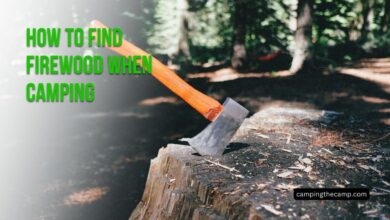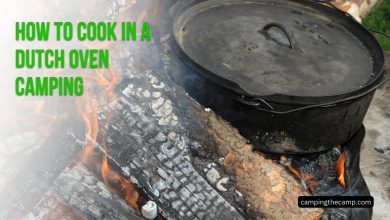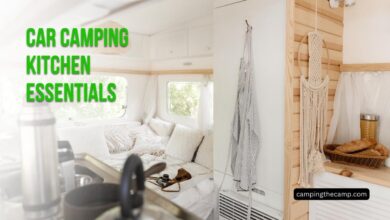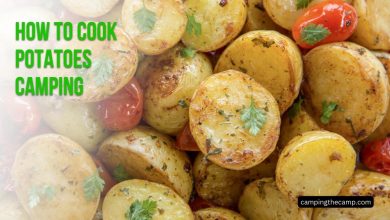Milk Camping with 6 Essential Tips for Keeping Cold

We have the ultimate guide to make your milk camping experience a breeze. In this short introduction, we will share six tips to keep your milk cold and delicious while you enjoy the great outdoors.
Camping is a beautiful way to connect with nature, but when it comes to keeping perishable items like milk cool, it can be pretty challenging. With the sun beating down and limited access to refrigeration, maintaining the freshness of your milk becomes crucial. Fortunately, we have gathered expert advice and practical solutions to ensure your milk stays cold throughout outdoor adventures.
From innovative cooling methods to clever storage ideas, these six essential tips are designed to make milk camping easy and enjoyable. No longer will you have to compromise on the simple pleasure of a cool glass of milk while immersing yourself in nature.
How to keep milk cold when camping
Keeping milk cold in outdoor settings can be a challenge, but with proper planning and the right equipment, it’s entirely achievable. In this guide, we’ll explore various effective methods and smart tips to help you keep your milk chilled and enjoyable throughout your camping adventures. From cooler selection to ice management techniques, get ready to discover practical solutions that will keep your milk cool and refreshing even in the great outdoors.
Get Good And High-Quality Cool Boxes
Cool boxes for milk camping, also known as ice chests or coolers, are essential for picnics, camping trips, or long road trips to keep food and beverages cool and fresh. They are typically designed with a thick layer of insulation and a hard plastic exterior to preserve the temperature inside.
There are three main types of cool boxes. Passive cool boxes rely on ice packs or frozen gel packs and are the most common and affordable type, but they require frequent replenishing of the cooling element. Active cool boxes, or thermoelectric cool boxes, connect to a power source such as a car’s 12V outlet, and they can both cool and heat their contents, offering more temperature control.
The third type, 3-way fridges or absorption coolers, are the most versatile, able to operate on 12V DC, 230V AC, or gas. However, they’re more expensive and larger, making them better suited for caravans or motorhomes. For good and high-quality cool boxes, look for robust construction, effective insulation, and convenient features like sturdy handles or wheels for easy transportation. Consider the size you need and the power source, if applicable.
Passive cool boxes
Passive cool boxes, commonly called coolers in the US, are ubiquitous during the camping season and available in most camping shops year-round. These cool boxes rely on pre-chilled items and ice packs to maintain a cold environment and are a great choice for short camping trips. However, investing in a higher-quality passive cool box, such as the Coleman Xtreme, can provide up to five days of cooling, making it an ideal choice for extended camping ventures.
Active Cool Boxes
Active cool boxes are a step up from passive cool boxes, featuring a 12V plug and an integrated fan system to maintain a cool interior. Some also come with a 240V mains plug, enhancing their performance when connected to a power supply. It’s important to remember that the fan system maintains a cool temperature; it doesn’t cool down the contents. Therefore, it’s recommended to start with already-cooled items. Also, it should be noted that using a 12V box will require power, and plugging it into your car can drain the car battery quickly. A good option for an active cool box is the Explora 24L 2 in 1 Electric Cooler. It will be necessary to run it from a 12V socket, a leisure battery, and a 12V adapter socket. If unplugged overnight, a 110-ah leisure battery can run an active cool box for approximately four days. This duration can be extended with the addition of solar panels.
Three Way Fridges
Three-Way Fridges are the premium choice in the world of cool boxes. They can operate on an electric hookup, a 12V leisure battery, or gas cylinders, offering exceptional versatility and performance. The main downside to these fridges is their high cost, with prices usually starting around £180 and often reaching £250 or more. Despite the cost, for those requiring reliable cooling, such as storing diabetic medication, these fridges are an excellent option and can operate on gas when off-grid.
Related: Motorcycle Camping Adventures
Prepare and Treat Your cool boxes properly
Proper preparation and treatment of your cool box, whether passive or active, significantly enhances its performance. Cool boxes are designed to maintain cool temperatures rather than actively cooling the contents. Therefore, it’s important to start with cold or even frozen items. This includes your dairy and food supplies, which should be chilled or frozen before being placed in the cool box.
A common camping hack is pre-freezing your milk and as much food as possible before your trip. This method is not only highly reliable, but it also helps maintain the internal temperature of the cool box, reducing the overall workload of the box. Even the most basic cool box should be able to keep pre-frozen milk and other frozen items like minced meat or bacon chilled from Friday through to Monday during a typical British summer. By treating your cool box properly and preparing your food items in advance, you can make the most of your cool box and ensure your food stays fresh throughout your camping trip.
Maximizing the efficiency of your cool box or camping cooler involves more than just freezing your food beforehand.
10 strategies to enhance the performance of your cooler
Shade the Cooler: Always place your cooler in a shaded spot rather than inside your tent or porch, and certainly out of direct sunlight.
Foil Lining: Line the cooler’s interior with foil to enhance insulation.
Damp Tea Towel: Cover a passive cooler with a damp towel and moisten it. Note: Do not apply this method to an active cooler.
Encourage Airflow in Active Coolers: When packing an active cooler, don’t pack it too tightly. Allow some space for airflow.
Discourage Airflow in Passive Coolers: Pack a passive cooler tightly to minimize airflow and retain cold air.
Use Ice Blocks or Store-Bought Ice: These can maintain a low temperature for extended periods.
Minimize Opening: Avoid opening the cooler more than necessary to prevent warm air from entering.
Last-Minute Packing: Pack your cooler at the last possible moment before leaving to maintain the internal temperature.
Space Blanket Wrap: Wrap your cooler in a space blanket to reflect sunlight and provide additional insulation.
Strategic Packing: Pack your cooler with a plan. Arrange items in the order you’ll need them—place the food needed later in the trip at the bottom and items for immediate use at the top.
Make a Meal Plan
Making a meal plan for your camping trip might not seem like the most exciting part of your adventure, but it brings significant benefits. Firstly, it ensures you’ll always have enough food for your trip, regardless of how well your fridge or cooler performs. Secondly, strategic meal planning can help maintain the efficiency of your cool box, aiding in its cooling capacity.
Planning meals allows you to anticipate potential issues, such as milk going sour or questioning whether the bacon is still fresh. With a well-thought-out plan, you can avoid these dilemmas and enjoy your meals worry-free. However, knowing your cool box’s specific capabilities and limits is essential for this planning to make perfect.
When packing the cool box, place the food intended for later consumption at the bottom and the food for the first night on top. This approach minimizes the need to rummage through the box and extends the cooling period for the items at the bottom, ensuring your food stays fresher for longer.
Swap Out Your Ice Packs
Rotating your ice packs can be a highly effective strategy for maintaining the cool temperature inside your cool box, especially if you’re camping at a site that provides freezing facilities. Most larger campsites offer such facilities, which allow you to keep a constant supply of ice packs for your cooler.
To implement this strategy, mark your ice pack with your name to ensure it doesn’t get mixed up with others’ ice packs. Fabric plasters can be useful, but remember to apply them when the ice pack is thoroughly dry, preferably before freezing.
Another tip for optimizing this strategy is to bring twice the number of ice packs you think you’ll need (or use water bottles as substitutes). This way, you can start freezing a set of ice packs as soon as you arrive at the campsite, ready to replace the ones in your cooler when they defrost.
However, remember that some campsites may charge a small fee for using their freezing facilities or operate on an honesty box or charity donation system. Always check the campsite’s policy before you rely on this method to keep your cool box chilled.
Utilizing a Stream for Natural Cooling
One traditional and nature-friendly method of keeping food cool while camping involves a nearby stream. This technique might not be applicable at every campsite or situation, but it can be as reliable as an electric hookup for maintaining cool temperatures when feasible.
To employ this method, you’ll need a mesh or canvas bag that allows water to pass through. Ensure your food is stored in waterproof bags—reusable silicone sandwich bags are suitable. Even your milk bottle should be bagged to prevent any accidental leakage.
After securing your food, tie the bag to a fixed point—like a sturdy tree, a dog spike, or a large rock—to prevent it from floating away. A strong rope, such as a paracord, is recommended to secure the bag.
The Bucket Trick
A variation of the stream cooling technique involves a bucket with water and a damp towel. Place your sealed food items and milk inside the bucket, cover it with a damp towel, and keep it in a shaded area.
While this method can be effective in cooler temperatures, it might only provide a few hours of cooling during hot periods, such as the August bank holiday.
Another alternative cooling method involves placing an earthenware jug or flower pot inside another flower pot, with a layer of damp sand in between. This setup has been shown to work effectively in maintaining cool temperatures. However, the practicality of carrying two large terracotta flower pots as part of your camping gear might be questionable!
Considering Non-Perishable Alternatives
If, despite all your efforts, your cool box doesn’t keep your food sufficiently cold, it might be time to reconsider your food choices. This could involve avoiding perishable items that require cooling all together.
For instance, if you’re a coffee drinker who needs milk, you might need to adapt based on the cooling capabilities of your cool box and the conditions at your campsite. This could involve opting for UHT milk, tins of condensed or evaporated milk, or dried milk powder, which doesn’t require refrigeration. Alternatively, you could purchase fresh milk daily in a store nearby.
In some cases, completely shifting your meal plan to include only items that don’t require cooling may be the most practical solution. This approach, known as a ‘no-cool box camp,’ can offer plenty of tasty and nutritious meal options, eliminating the worry of keeping perishable food items fresh.
Related: Boot Camp For Kids
FAQ
How do you store and carry milk while camping?
You may be tempted to bring your milk in its carton, but that could be a problem if you want to prevent leaks and skills. Instead, transfer the milk to an airtight, leak-proof container. Go for plastic over the glass to prevent breakage.
This camping-friendly pitcher is leak-proof and made with BPA-free plastic, making it perfect for storing milk and conveniently pouring the amount you need out of its spout.
How long does milk last while camping?
That depends on how you’re storing it. If you’re keeping it in a cooler with ice, it can probably stay cool for 24 to 48 hours.
It depends on how big your cooler is, what kind of cooler it is (a.k.a. how well it insulates), how often you’re opening and closing the cooler, the outside temperature, and the other items being stored inside the cooler—including the size and thickness of your ice cubes or ice packs.
Two days are generally the limit for keeping most foods and beverages cool in a standard cooler. We’d recommend planning to consume your milk within that time frame.
How do you keep milk cold for three days or longer while camping?
To keep milk cool longer than the general two-day maximum with most standard coolers, you’re going to a more high-tech cooler, like an active or passive ice box, to keep stored items cool for up to several days.
Unfortunately, active and passive ice boxes aren’t the most practical options for campers because they’re large, heavy, expensive, and require battery charging.
Can I use frozen water bottles in my cooler to keep the milk cooler?
Yes, this is another option for regular ice cubes or ice packs to help keep your milk cold. The benefit is twofold—your milk stays cold, and when the water bottles thaw, you can drink them.




